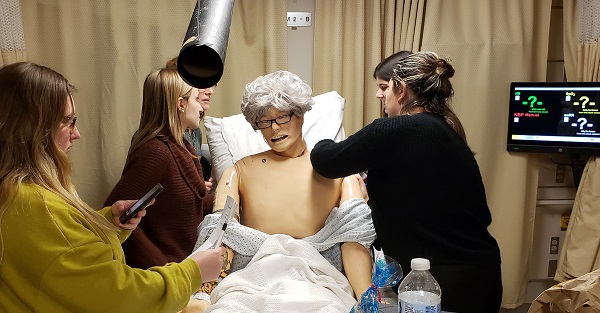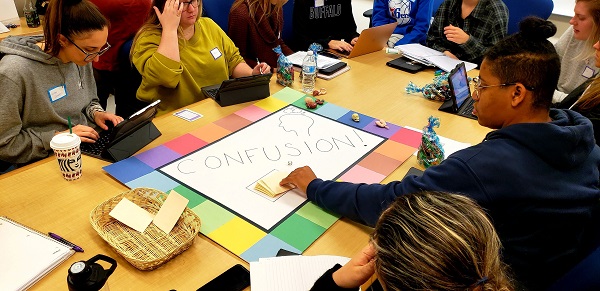Using Escape Rooms to Review for Exam
March 1, 2021
 A bevy of nursing students surround a Philadelphia hospital bed in which a man lays supine, struggling to breathe. They evaluate the patient as quickly as possible, taking vitals and asking him questions – but he’s confused and unable to provide succinct answers. Two nurses work together to help shift the man forward so they can use a stethoscope to assess his breathing from behind, when they find a sheet of paper with a QR code printed on it. The group looks at each other, wide-eyed in surprise, and one pulls out a phone to scan the code. They are rewarded with a clue to the man’s condition. As they continue to examine the patient and his surroundings, they find and solve more pieces of this puzzle.
A bevy of nursing students surround a Philadelphia hospital bed in which a man lays supine, struggling to breathe. They evaluate the patient as quickly as possible, taking vitals and asking him questions – but he’s confused and unable to provide succinct answers. Two nurses work together to help shift the man forward so they can use a stethoscope to assess his breathing from behind, when they find a sheet of paper with a QR code printed on it. The group looks at each other, wide-eyed in surprise, and one pulls out a phone to scan the code. They are rewarded with a clue to the man’s condition. As they continue to examine the patient and his surroundings, they find and solve more pieces of this puzzle.
Across the room, another team pours over objective data, including the patient’s lab results and EKG. They, too, find QR codes and are presented with clues that confirm what they’ve found in his chart. The two groups then come together to share their findings with each other. Between the environmental, context and electronic clues, they correctly diagnose their patient with heart failure and escape the room.
At the College of Nursing and Health Professions, undergraduate students are engaged in a simulation lab built on a similar premise to the concept of an Escape Room. This is not a team of seasoned nurses in a hospital setting, but a group of ten accelerated career entry nursing students in their Pathophysiology (patho) exam review. Their professors, Jen Carroll, MSN, assistant clinical professor, and Penny Parker, MSN, at the time an assistant clinical professor but now adjunct, along with help from countless CNHP faculty members, most notably Kate Morse, PhD, assistant dean for Experiential Learning and Innovation, created a class period of games, including this escape room scenario, a homemade board game, a VR experience and a rousing round of Jeopardy, to not only make exam review fun, but to also make the material more memorable.
 They were attracted to this idea specifically because “Escape rooms are these problem-based scenarios that utilize teamwork, team communications and a set of clues and help people make sense of these clues and escape the room. Research shows escape rooms support and promote student engagement and allow for the problem solving we want them to do,” explained Parker. “The students become an active participant in a fun learning modality.”
They were attracted to this idea specifically because “Escape rooms are these problem-based scenarios that utilize teamwork, team communications and a set of clues and help people make sense of these clues and escape the room. Research shows escape rooms support and promote student engagement and allow for the problem solving we want them to do,” explained Parker. “The students become an active participant in a fun learning modality.”
Carroll came up with the idea during faculty orientation in her first week working at Drexel. “There were many presentations about Drexel’s emphasis on experiential learning, and I thought, wouldn’t it be so cool to have these undergraduate students do an escape room?” she recalled. She brought Parker on board and the two took the idea to Morse who helped bring their concept to life.
This is an example of gamification of learning, a form of active learning in which students participate, interact and engage with the material using gaming elements in the learning environment. Competition or motivation to win prizes make learning fun and encourage student engagement and can create an addiction to learning. “It gives them that little squirt of dopamine that keeps them going back for more,” said Morse.
Bringing games into the classroom isn’t just for fun—there is science behind it. When learners actively participate, it triggers multiple sections of the brain, including the hippocampus, and helps facilitate new connections within it. This then converts short term into long term memory, or memory retention. “We actually remember more deeply what we learn when we are either emotionally activated, having fun or when there's some salient experience,” Carroll elaborated. By engaging with the material students are able to better understand and apply it, not simply memorize facts.
In the debrief following the exam review activity, Carroll said she could see students connecting all of the dots between their patho knowledge and why they solved certain clues in certain ways.
Feedback from the students was overwhelmingly positive. When asked if they plan to run the escape room again, Parker exclaimed “Heck yeah!” to which Morse added “We have big plans.”
By Maggie McCrea